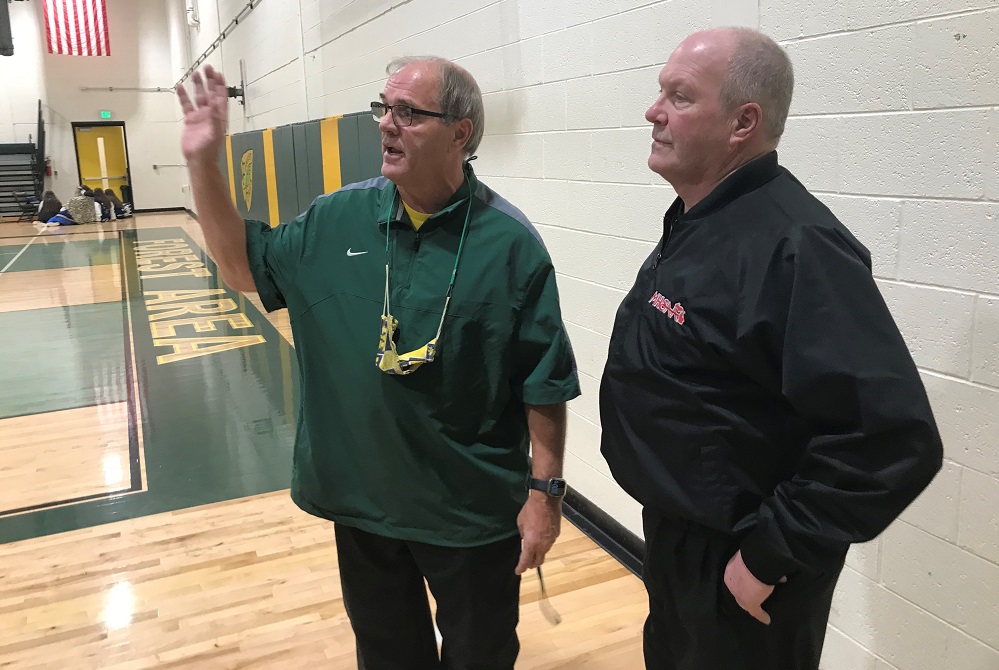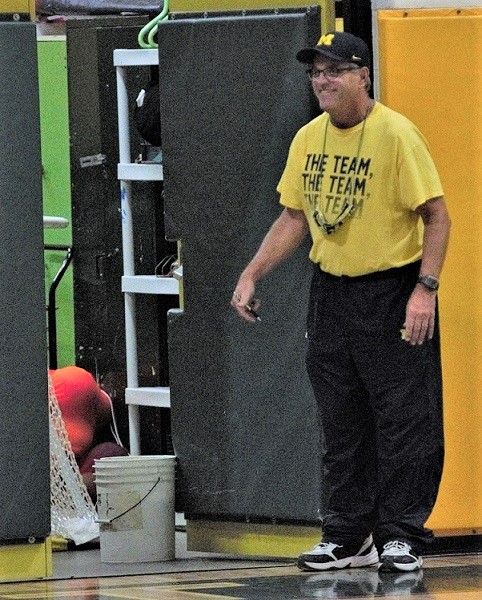
Working Through Transfer Trends
December 2, 2015
By Jack Roberts
MHSAA Executive Director
One of the responsibilities that schools have asked organizations like the MHSAA to execute is the management of transfer student eligibility. Historically, many associations have linked eligibility to residence ... thus, for some the regulation has been called the “Residency Rule” or “Transfer/Residency Rule,” not merely the “Transfer Rule.”
Over the years, as society became more mobile and families less stable, these rules became more and more complicated; and now, for most state high school associations, this is the regulation that consumes the most (or second) most pages of their handbooks. Over the years, this has also been the regulation most frequently challenged in court.
Over the years, some states have relaxed their transfer rule and others have refined their transfer rule. In either case, the transfer rule remains an imperfect rule, an imperfect net. Sometimes this net snags students who should not be made ineligible, and for those situations all associations have arranged some kind of waiver or appeal process.
And sometimes, and much less easily solved, the net fails to catch the situations it really should ... the transfers that are not hardship related or the result of some very compelling educational need, but those that are obviously for athletic reasons. It is those that we have been most focused on in Michigan.
Our first effort to get at the most problematic transfers was the adoption for the 1997-98 school year of what we called the “Athletic-MOTIVATED Transfer Rule” ... Regulation I, Section 9(E). Examples of an athletic-motivated transfer are included in the rule. The rule only applies to transfer students who do NOT meet any of the stated exceptions for immediate eligibility and are ineligible for one semester under our basic transfer rule. They become ineligible for 180 scheduled school days if there is a finding that the transfer was more for athletics than any other compelling reason.
This effort has not been successful enough because it requires a school that loses a student to another school to promptly allege to the MHSAA office, with supporting documentation, that the transfer was more for athletic reasons than any other compelling reason. The receiving school then must respond to those allegations. Then the executive director makes the decision. The unfortunate result of applying this rule is that it usually causes hard feelings between the schools, and hard feelings toward the executive director by the school decided against. In 17 years, schools have invoked this rule only 45 times.
Our more recent effort to address the most egregious athletic transfers resulted from requests from the coaches associations for wrestling and basketball, which were watching too many students change schools for athletic reasons, usually related to an out-of-season coaching relationship. The new rule – the “Athletic-RELATED Transfer Rule” – is Regulation I, Section 9(F). The difference between Section 9(E) and the newer Section 9(F) is that in 9(F) one school does not have to make and document allegations before staff can act. If MHSAA staff discover or are informed of any of the circumstances listed in 9(F), we can act. Again, the rule only applies to those transfer students whose circumstances do NOT meet one of the automatic exceptions. It applies only to students who are ineligible for a semester under the basic transfer rule. If there is a finding that one of the athletic related “links” exists (usually an out-of-season coaching relationship), then this transfer student who would be ineligible for one semester is made ineligible for 180 scheduled school days.
So far, it appears that 9(F) may be a better deterrent than 9(E). It has been referenced when students are rumored to be transferring, and it has stopped many of those transfers before they occur. We expect 9(F) to be an even better deterrent in 2015-16 because the rule has been broadened to apply to administrators and parents (not just coaches) and to address directing and coordinating athletic activities (not just coaching).
We have said that if this latest effort does not succeed in slowing athletic transfers, then the next step is 180 days of ineligibility – at least in any sport the student played in high school previously – for all transfer students who do not qualify for an exception that permits immediate play. I fear that would catch far too many students who should not be withheld so long from competition and could lead to a period like the early 1980s when the MHSAA, at the request of the state principals association, adopted the core of the transfer rule we have today and which resulted in a period of busiest litigation for the MHSAA when, at one time, the association had more than a dozen cases in court simultaneously on transfer matters. We’ve got to make the current rules work – with tweaks, perhaps; but not with radical revision.

Forest Area's Stremlow Never Far from Serving School Sports Community
By
Tom Spencer
Special for MHSAA.com
February 4, 2022
He hasn’t met a sport he can’t coach. And, he probably hasn’t turned down a team he’s met – yet.
 Many of the coaching jobs he’s taken were actually offered to him by him.
Many of the coaching jobs he’s taken were actually offered to him by him.
Whenever he’s started a new sport, he’s sought mentors in the form of successful veteran coaches. But make no mistake, if they made a movie in Northern Michigan called “The Mentor” – this Hall of Fame coach would be the star of the show.
He’s technically retired today. The teams he coaches don’t get TV cameras and other media present. He’s a middle school track and volleyball coach for Fife Lake Forest Area Community Schools.
He’s perhaps most well-known as the past volleyball coach at Forest Area. Don’t be surprised if you hear of graduated athletes – and current student-athletes – from Glen Lake, Manton, Kingsley and even McBain Northern Michigan Christian happily call him “Coach.”
Name the coach? Ron Stremlow. He’s a retired physical education teacher, athletic director and coach. He came out of retirement to return as the part-time athletic director for Forest Area, a district he served 32 years as a teacher.
He’s also coaching a couple of middle school sports, just like he did when he was working full-time. Athletic directors often need to put themselves in tough-to-fill coaching slots.
“Ron Stremlow has been a tremendous ambassador of high school sports in Northern Michigan,” said Dave Jackson, athletic director of Frankfort-Alberta Schools. “The number of coaches, parents and athletes Ron has encouraged during his years of service are too many to count.
“He is an athletic administrator that has always been about service and what (he) can do to help.”
Help is exactly what he did once upon a time for then-new volleyball coach at McBain Northern Michigan Christian, Diane Eisenga. The call for help came from Eisenga’s players.
Today, Eisenga is an athletic assistant for the Comets and mother of five boys, her youngest still attending NMC. Like Stremlow, she has built a very successful program. Back then, she was just getting started, pregnant and a mother of two children, and unable to coach her team during a Ferris State University tournament that Stremlow had planned to scout with longtime friend and Kingsley 1,000-win volleyball coach Dave Hall.
Stremlow actually was planning to watch NMC at the tournament, anticipating the Comets would be a potential roadblock to a District title that upcoming season. (He was right: Forest Area would end up losing to NMC in a District Final as the Comets reached the Class D Quarterfinals.)
 What Stremlow did not anticipate was being asked by the Comets players to step in and coach them at the Ferris tourney. Stremlow was told Eisenga was not feeling well enough to guide the team at that moment.
What Stremlow did not anticipate was being asked by the Comets players to step in and coach them at the Ferris tourney. Stremlow was told Eisenga was not feeling well enough to guide the team at that moment.
Stremlow did not hesitate to help. He had previously leant his wisdom to the former Dordt University (Iowa) athlete with tryouts, cutting decisions and NMC’s summer camp.
“I had played in high school and college, but I was green,” Eisenga acknowledged. “He was a good mentor.”
She recalls her players asking for Stremlow’s help.
“I got real light-headed and wasn’t feeling well,” she said. “Because the girls had known him, he took over for me that day.”
It wasn’t a surprise for Eisenga to witness Stremlow’s contribution to her team’s success that year.
“I always saw him as more of a mentor and more of a friend (than an opposing coach),” Eisenga said. “He was happy with anyone’s success.
“He was always happy for any team that played well,” she continued. “Of course, he always wanted his own to win. … He was always respectful, and you never saw him cross the line.”
Stremlow, who jokes about maybe not having the most wins among hall of fame volleyball coaches while claiming the most losses amongst the elite group (he still ranks 17th in MHSAA history with 944 volleyball wins despite retiring from the Forest Area varsity after the 2018 season), spends his days taking care of Forest Area boys and girls basketball, completive cheer and the Warriors co-ed wresting teams. Many a night he does whatever it takes to run an event, including running the scoreboard for basketball.
In the fall, Forest Area offers 8-player football, cross country and volleyball. He’s in the midst of finalizing spring softball, track and baseball.
Basketball is perhaps his favorite sport, but he loves the change of seasons.
“Once that season’s up, I am ready to rock and roll and get into another,” Stremlow noted.
Giving back is what keeps the 62-year-old Stremlow going. He sees at least three years of involvement ahead.
“A lot of kids do not get good role models or good coaches. And I thought if I can help kids out, I am going to,” Stremlow said.
Today Stremlow wears many school colors, especially the Warriors’ forest green. You also often can find him in Kingsley orange, or perhaps it is actually the Manton orange.
You will definitely find him in his favorite, maize and blue. His forest green should never be confused with the Michigan State green. The Wolverines became the favorite of the Central Michigan grad when he got into the Big House as a high school student with a $2 ticket to watch Michigan take on Navy.
“I have green, but it is not the Michigan State green,” Stremlow said he often jokes with fans of the Spartans and Warriors.
Stremlow uses all his team colors as he follows another passion, photography. He got a camera for college graduation, and student-athletes all over Northern Michigan have benefited.
“There are thousands of former players from Forest Area and Kingsley that can point to pictures in their homes that Ron has taken of them playing sports,” Jackson said. “These pictures are not just cute shots, but pictures that were used to teach form and techniques.”
Stremlow takes satisfaction from capturing sports on film, rather digitally, as he does today.
“I take a lot of pictures – I‘ve always liked it,” he said. “That’s the best gift you can give any kid and parents – just getting pictures.
“It really helps, plus I like doing it.”
 Tom Spencer is a longtime MHSAA-registered basketball and soccer official, and former softball and baseball official, and he also has coached in the northern Lower Peninsula area. He previously has written for the Saginaw News, Bay County Sports Page and Midland Daily News. He can be reached at [email protected] with story ideas for Manistee, Wexford, Missaukee, Roscommon, Ogemaw, Iosco, Alcona, Oscoda, Crawford, Kalkaska, Grand Traverse, Benzie, Leelanau, Antrim, Otsego, Montmorency, Alpena, Presque Isle, Cheboygan, Charlevoix and Emmet counties.
Tom Spencer is a longtime MHSAA-registered basketball and soccer official, and former softball and baseball official, and he also has coached in the northern Lower Peninsula area. He previously has written for the Saginaw News, Bay County Sports Page and Midland Daily News. He can be reached at [email protected] with story ideas for Manistee, Wexford, Missaukee, Roscommon, Ogemaw, Iosco, Alcona, Oscoda, Crawford, Kalkaska, Grand Traverse, Benzie, Leelanau, Antrim, Otsego, Montmorency, Alpena, Presque Isle, Cheboygan, Charlevoix and Emmet counties.
PHOTOS (Top) Fife Lake Forest Area athletic director Ron Stremlow talks with official Chuck Bott (right) before a basketball game against Indian River Inland Lakes this season. (Middle) Stremlow shows support for his favorite college team while prepping before a game against Johannesburg-Lewiston. (Top photo by Tom Spencer; middle photo by Andrew Fish/Gaylord Herald-Times.)

